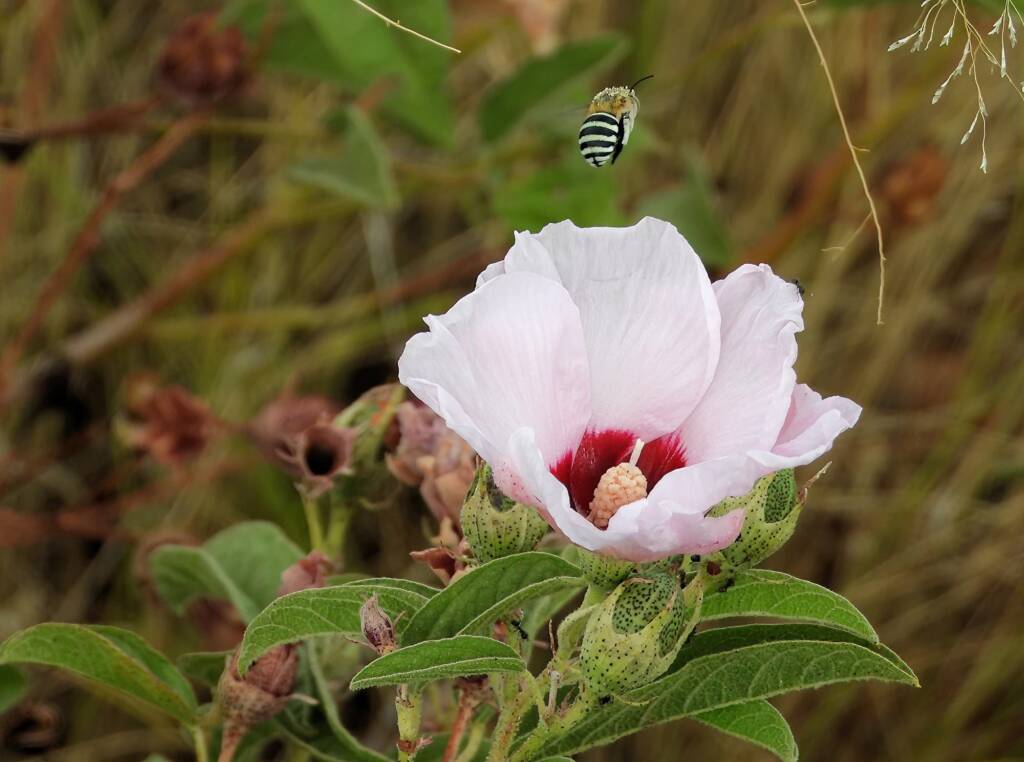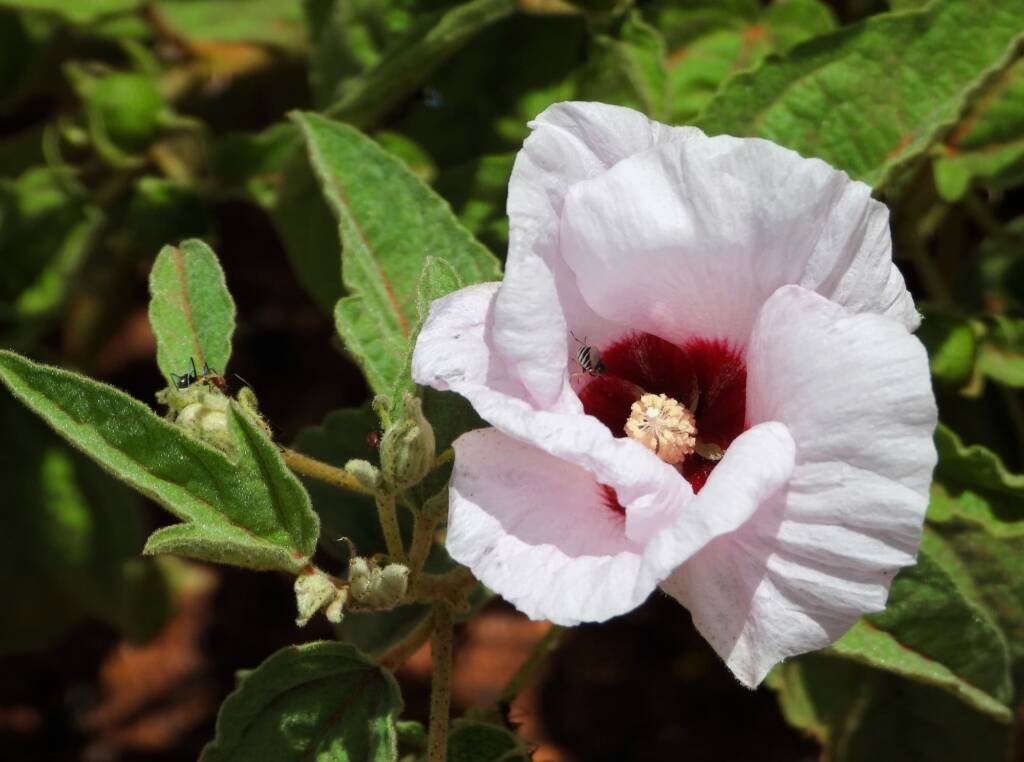The Gossypium is the largest genus in the tribe Gossypieae, with 50 Gossypium species and new species being discovered. There are 17 species of Gossypium (see list in scientific classification on this page) indigenous to Australia. The genus name derived from the Arabic word goz, which refers to a soft substance.
There are 17 Gossypium species indigenous to Australia. These species comprise three genetically and morphologically distinct groups recognized taxonomically as three sections within Gossypium subgenus Sturtia and cytogenetically as three genomes.
Source: Biogeography of Australian Gossypium Species, Australian National Botanic Gardens1
The C-genome (section Sturtia) contains the well known Sturt’s Desert Rose (Gossypium sturtianum) and its western relative, G. robinsonii. Sturt’s Desert Rose can be found in seasonally dry creek beds in the temperate arid zones of all the mainland states. The G. robinsonii occurs only in the Pilbura region of Western Australia. Both species are large well-branched shrubs with mauve flowers with a deep maroon petal spot at the base of each petal.

There are three G-genome species, Gossypium australe, G. bickii and G. nelsonii. They are seen as low / spindly shrubs in the dry-monsoon and warm arid regions of Western Australia, Northern Territory and Queensland. Gossypium australe is the most widespread of the species, often found along road verges. Gossypium bickii and G. nelsonii are mostly found in small populations in the Northern Territory and western Queensland. These G-genome species are sometimes known as Desert Roses due to the flower similarity to those of Sturt’s Desert Rose.

The 12 K-genome species Gossypium rotundifolium, occur in small populations in the monsoonal regions of the Kimberley in northern Western Australia. The K-genome species possess a unique seed dispersal mechanism that is found no where else in the genus. The flowers are upright, but as the fruit develops, the stem curves toward the ground dropping the seed directly onto the ground when the fruit opens. The seeds have a fleshy appendage that attracts ants, which disperse the seed.1

The flowers of the Gossypium are popular with many insects, such as ants, Amegilla bees (also known as Blue-banded Bees), Australiphthiria sp, spiders that often prey on visiting insects, and European Honey Bee.

Olive Pink Botanic Garden, Alice Springs, NT

Olive Pink Botanic Garden, NT
- Scientific classification
- Kingdom: Plantae
- Phylum: Charophyta
- Class: Equisetopsida
- Subclass: Magnoliidae
- Superorder: Rosanae
- Order: Malvales
- Family: Malvaceae
- Genus: Gossypium
- Subgenus: Sturtia
- Section: Sturtia
- Species:
- Gossypium robinsonii
- Gossypium sturtianum (include G. nandewarense)
- Species:
- Section: Hibiscoidea
- Gossypium australe
- Gossypium bickii
- Gossypium nelsonii
- Section: Grandicalyx
- Gossypium costulatum
- Gossypium cunninghamii
- Gossypium enthyle
- Gossypium exiguum
- Gossypium londonderriense
- Gossypium marchantii
- Gossypium nobile
- Gossypium pilosum
- Gossypium populifolium
- Gossypium pulchellum
- Gossypium rotundifolium
- Gossypium species nova
- Section: Sturtia
- Subgenus: Sturtia
Footnote & References
- Cotton Molecular Genetics, Australian National Botanic Gardens, https://www.anbg.gov.au/cpbr/program/sc/cotton_mole.htm
- Gossypium L., Atlas of Living Australia, https://bie.ala.org.au/species/https://id.biodiversity.org.au/taxon/apni/51288462
FloraFlora in Australia Flora Index Acacia Anigozanthos (Kangaroo Paws) Annual Yellowtop Apium prostratum subsp. prostratum var filiforme Apple Bush (Pterocaulon sphacelatum) Australian Bluebell Australian Gossypium Banksia Batswing Coral Tree Billy Buttons Birdsville Indigo Blue Pincushion Bush Banana Callistemon Callitris drummondii (Drummond’s Cypress Pine) Calothamnus quadrifidus Cape Honeysuckle Cassia fistula (Golden Shower) Cattle Bush Common Heath Crotalaria Darwinia wittwerorum (Wittwer’s Mountain Bell) Daviesia oppositifolia (Rattle-pea) Desert Oaks Drumsticks Eremophila Eucalyptus Ficus Flannel Cudweed (Actinobole uliginosum) Georges Indigo Goatshead Burr (Sclerolaena bicornis) Golden Everlasting Goodenia Gossypium Grass and Grasses Grass Trees Grevillea Grey Germander Hakea Kapok Bush (Aerva javanica) Lambertia sp Leptospermum MacDonnell Ranges Cycad Maireana scleroptera Mexican Poppy Minnie Daisy Mistletoe Family Nardoo Native Apricot Nicotiana megalosiphon subspecies sessilifolia Nuytsia floribunda Orange Spade Flower Orchidaceae Parakeelyas (Calandrinia) Pebble Bush (Stylobasium spathulatum) Perennial Yellow Top Pink Everlasting Pink Rock Wort Poached Egg Daisy Portulaca Proteaceae Ptilotus Quandong Resurrection Fern Rosy Dock Ruby Saltbush Santalum Solanum Spike Centaury Spinifex Storkbill (Erodum cygnorum) Striped Mint Bush Sturt’s Desert Pea Sturt’s Desert Rose Tall Saltbush Tangled Leschenaultia Tar Vine Tribulus eichlerianus Upside-down Plant Urodon dasyphylla Variable Daisy Waratah (Telopea) Wertabona Daisy White Cedar (Melia azedarach) White Indigo White Paper Daisy Wild Passionfruit Wild Stock Woolly-Headed Burr Daisy Woolly Bush Yellow-keeled Swainsona
Flora & FaunaFauna Flora Fauna Flora Funga Glossary Funga Related Topics Scientific Classification Backyard Wildlife Floral Emblems of Australia Wildflowers
